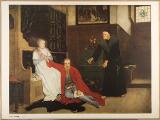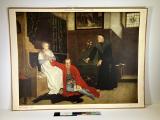Eric XIV is faced with the decision to sign the death sentence for several Swedish nobles, including many members of the Sture dynasty, who are imprisoned and awaiting their sentence. The year is 1567 and the nobles will come to be killed in the so-called Sture Murders. The scene itself is a concentrated version of a longer story.
The middle of the wallchart depicts the anxious and pensive Eric XIV, dressed in red with a paper in his hand. He is sitting on the floor and leaning against his lover and wife to be, Karin Månsdotter, who is dressed entirely in white. She holds his hand and looks fearfully at the king’s prosecutor, Jöran Persson. Persson is dressed entirely in black and partly hidden in the shadows. He looks disapprovingly back at Karin and hands a quill to the king.
The artist wanted to depict this dramatic moment and the battle between good, in the form of the young Karin Månsdotter, and evil, in the form of Jöran Persson. He shows the anxiety felt by Eric, who believes himself to be the subject of a conspiracy, and strengthens this through the sequence of chosen colours: white, red, black.
The scene depicts Karin Månsdotter as an innocent figure, and not as a dangerous seductress who has manipulated the king, which had been a common image beforehand. The artist has instead taken the position that Jöran Persson was behind many of the decisions with fatal consequences signed by Eric XIV. Later historical accounts have shown that Persson prompted or encouraged the king to the highest degree in many of the matters that resulted in Eric XIV being imprisoned. The painting is in many ways typical of its time in its depiction of the battle between good and evil, innocence and malevolence, light and dark.
In 1568, Eric XIV was deposed by his brothers John and Charles. One reason for this was that he suffered from mental illness and paranoia. Another was that he had married his concubine (a lover who had the approval of the court), Karin Månsdotter. She was the daughter of a jailkeeper at the Tre Kronor Castle and 15 years-of-age when the king, who was 32 at the time, took a liking to her. She is said to have had a calming influence on him. Eric XIV was murdered by arsenic poisoning in prison in 1577.
Karin Månsdotter was given an estate in Finland where she lived a peaceful but affluent life up until her death in 1612.
Jöran Persson was not a noble, but became Eric’s right hand man and prosecutor in the king’s private court, the Höga Nämnden. He was hated by many and especially by the nobility. The dark image of Jöran Persson was created after his death by his worst enemies. In connection with Eric’s deposition, Jöran Persson was tortured, executed and dismembered.
The wallchart is inspired by an oil painting by Georg von Rosen from 1871, which is currently on display at the National Museum.
From the series Swedish Historical Wallcharts, 1932.



 ARTIKLAR I WIKIPEDIA
ARTIKLAR I WIKIPEDIA ARTIKLAR I WIKIDATA
ARTIKLAR I WIKIDATA BILDER I WIKIMEDIA COMMONS
BILDER I WIKIMEDIA COMMONS





